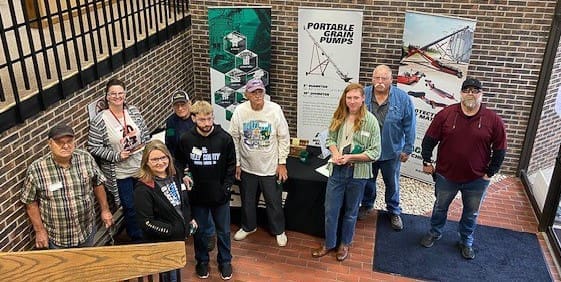By Quinn O’Hara
On Friday, October 6th, AGI Hutchinson-Mayrath hosted three tours of their Clay Center manufacturing plant. Groups walked through each section of the facility, and learned how each custom order is taken from an idea to a physical product and sent around the world for use in the drying, transportation, and storing of food crops.
The day’s tour guide and plant manager, Sheldon Rozean, discussed several ways in which Hutch has grown in the past few years.
Efficiency is the name of the game for Rozean and AGI. Each day a new individualized information packet is handed out to each section of the production line. It is color coded to the day of the week it was released, and contains the instructions, a parts list, and a record of any other necessary information needed to complete an order. As the order is transferred to different sections of the plant, the packet is always in tow. If a plant manager sees that a packet from several days prior is still on the floor, they will know to transfer workers from an ahead of schedule order to help the behind order catch up.
Each worker is trained in at least three separate areas of the plant by the end of their first month. This assures every worker will have a job to do throughout the day, which helps avoid layoffs and halts in production due to a bottleneck. Since Rozean implemented the cross-training adjustment five years ago, not one employee has been laid off.
Though every order and product are uniquely tailored to the customer’s specific requirement, Hutch does it’s best not to “reinvent the wheel” as Rozean put it.
“We have over 77,000 individual parts detailed in our system, but most times we just edit the lengths and sizes of individual pieces as needed.” He explained. The packet system also details these discrepancies to assure each order is made accurately.
The plant does its best to recycle and reduce the overall amount of waste after each step as much as possible. Everything from shop dust to cardboard is recycled. Any scrap metal remaining, usually just 10% of the original sheet, is sent to Hess Salvage to be recycled. They have yet to find a way to recycle leftover wooden pallets however, and welcome anyone in need to pick up as many as they can take, free of charge.
Safety is another factor in which Hutch excels. Utilizing a hanging conveyor system, each part is held aloft by chains during production. This significantly reduces the amount of lifting required and prevents unnecessary back injuries. They also have several PPE, or personal protective equipment, vending machines scattered around. If an employee is missing gloves or has worn a hole in them, they simply scan their ID card into the machine and select the necessary items. Rather than charge for the equipment, the machines are utilized to track the use and inventory of each type of product, as well as to keep the items in place and avoid a worker spending unnecessary time looking for said items.
Several tour participants were former workers at the plant who wanted to see what all has changed over the years. One older gentleman, Steve Charbonneau, worked as a welder for the company 40 years ago, during summer and winter breaks from college. During the tour Charbonneau noticed parts of a conveyor he welded all those years ago were still in use for the exact same purpose he made them for. Aside from a few other subtle things, most former employees mentioned a number of changes to the plant, and several said it was almost unrecognizable.
Rozean echoed these sentiments at the end of the tour, mentioning how much has changed in the short time he has been with Hutchinson Mayrath, and even more than that has changed since his parents first worked at the plant.













